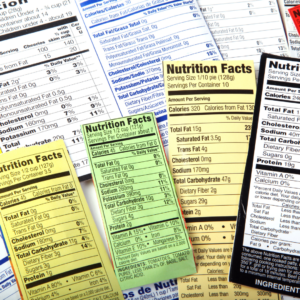 The importance of reading food labels cannot be overlooked. If you ever want to avoid weight gain, diabetes, heart disease, and various other health problems, it is imperative to read every single word of your food label every time you go grocery shopping.
The importance of reading food labels cannot be overlooked. If you ever want to avoid weight gain, diabetes, heart disease, and various other health problems, it is imperative to read every single word of your food label every time you go grocery shopping.
Labeling has gotten a lot more complicated in recent years with the rise of processed foods. There are various “healthy” diets that require very specific ingredient information to be considered “approved”. For example, someone following a Paleo diet would need to know about hidden sources of carbs or sugar such as those found in honey or fruit juice concentrate. On the other hand, people on the gluten-free diet might have different sensitivities to watch out for—e.g., certain grain flours containing animal products might not fit into their diet either.
The best way to learn how to read a label is by actually doing it yourself at home with your groceries and snacks that you already have at home so that you can be familiar with what goes into them and thus make better choices when shopping for food items in the future. In addition to showing you what’s in your food, there are other reasons why it’s important to read labels:
They provide information that’s vital for your diet
When you’re eating something, it’s easy to not pay much attention to what it contains. However, when you’re on a diet of any kind or managing a medical condition, reading ingredients and food labels is very important. Ingredients often provide vital information that’s beneficial to your diet such as if the types of foods it contains, chemicals, and allergens.
It helps you with diet planning
If you’re one of the millions of Americans suffering from chronic conditions like diabetes, high blood pressure, or heart disease, or if you just want to make sure your body is functioning at its best, it’s important to keep track of certain numbers. For instance, if you have diabetes, your doctor will most likely tell you that you need to watch your blood sugar (which means eating right and exercising). Other important numbers range from sodium intake to saturated fat content—all of which can be found on the food label. You may not think it sounds interesting or fun to take a look at this small slip of paper before deciding what to eat, but those numbers could mean the difference between living a long and happy life and coming down with a debilitating illness. Not all labels will follow the same format—some will include more information than others—but no matter what type of label it is, all are worth taking a look at.
It can help you identify ‘sugar’ content
Sugar is the number one ingredient in many processed foods. The problem with this is that it is often hidden under multiple names and added to products where you would never expect it to be. These include ingredients like brown rice syrup, dextrose, fruit juice concentrate, and evaporated cane juice. The good news is that by learning how to read food labels, you can quickly identify which products contain a significant amount of added sugar. Once you know what to look for, it becomes much easier to make healthier choices at the grocery store.
It helps you understand the calories per serving
Some people don’t realize it, but the number of calories on a label is actually per serving — not per piece of food (which is usually two or more servings). So if you’re trying to lose weight or maintain your current weight, reading labels can help ensure you’re not getting too many calories at once.
It helps you keep a tab on bad fats
The total amount of fat in each serving is listed right under the Nutrition Facts label, but some people don’t realize that this includes both good fats and bad ones. If you’re trying to eat healthy, make sure to look at how many grams of total fat you’re consuming each day. For example, if one serving has 8 grams of fat but 5 of those are from monounsaturated fats (like olive oil), then it’s not necessarily as bad as if all 8 grams were saturated fats (those found in animal products).
Ultimately, the best advice to follow when it comes to reading food labels is to read the label of any food item that you are unfamiliar with. These labels are where you will find the most detailed information about a specific food product, including ingredients. This way, you can safely determine what you want and/or don’t want to ingest. After all, learning how to read food labels is a valuable skill to have in today’s world.
Find out more about our services here, and don’t forget to follow us on social media!
